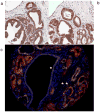Overexpression of fatty acid synthase is associated with palmitoylation of Wnt1 and cytoplasmic stabilization of beta-catenin in prostate cancer
- PMID: 18838960
- PMCID: PMC3223737
- DOI: 10.1038/labinvest.2008.97
Overexpression of fatty acid synthase is associated with palmitoylation of Wnt1 and cytoplasmic stabilization of beta-catenin in prostate cancer
Abstract
Fatty acid synthase (FASN), a key metabolic enzyme for liponeogenesis highly expressed in several human cancers, displays oncogenic properties such as resistance to apoptosis and induction of proliferation when overexpressed. To date, no mechanism has been identified to explain the oncogenicity of FASN in prostate cancer. We generated immortalized prostate epithelial cells (iPrECs) overexpressing FASN, and found that (14)C-acetate incorporation into palmitate synthesized de novo by FASN was significantly elevated in immunoprecipitated Wnt-1 when compared to isogenic cells not overexpressing FASN. Overexpression of FASN caused membranous and cytoplasmic beta-catenin protein accumulation and activation, whereas FASN knockdown by short-hairpin RNA resulted in a reduction in the extent of beta-catenin activation. Orthotopic transplantation of iPrECs overexpressing FASN in nude mice resulted in invasive tumors that overexpressed beta-catenin. A strong significant association between FASN and cytoplasmic (stabilized) beta-catenin immunostaining was found in 862 cases of human prostate cancer after computerized subtraction of the membranous beta-catenin signal (P<0.001, Spearman's rho=0.33). We propose that cytoplasmic stabilization of beta-catenin through palmitoylation of Wnt-1 and subsequent activation of the pathway is a potential mechanism of FASN oncogenicity in prostate cancer.
Figures





Similar articles
-
Fatty acid synthase: a metabolic enzyme and candidate oncogene in prostate cancer.J Natl Cancer Inst. 2009 Apr 1;101(7):519-32. doi: 10.1093/jnci/djp030. Epub 2009 Mar 24. J Natl Cancer Inst. 2009. PMID: 19318631 Free PMC article.
-
Caveolin-1 interacts with a lipid raft-associated population of fatty acid synthase.Cell Cycle. 2008 Jul 15;7(14):2257-67. doi: 10.4161/cc.7.14.6475. Epub 2008 May 12. Cell Cycle. 2008. PMID: 18635971
-
P300 acetyltransferase regulates fatty acid synthase expression, lipid metabolism and prostate cancer growth.Oncotarget. 2016 Mar 22;7(12):15135-49. doi: 10.18632/oncotarget.7715. Oncotarget. 2016. PMID: 26934656 Free PMC article.
-
Pharmacological inhibitors of Fatty Acid Synthase (FASN)--catalyzed endogenous fatty acid biogenesis: a new family of anti-cancer agents?Curr Pharm Biotechnol. 2006 Dec;7(6):483-93. doi: 10.2174/138920106779116928. Curr Pharm Biotechnol. 2006. PMID: 17168665 Review.
-
Involvement of the pro-oncogenic enzyme fatty acid synthase in the hallmarks of cancer: a promising target in anti-cancer therapies.Oncogenesis. 2023 Mar 18;12(1):16. doi: 10.1038/s41389-023-00460-8. Oncogenesis. 2023. PMID: 36934087 Free PMC article. Review.
Cited by
-
Fatty acid synthase as a potential therapeutic target in cancer.Future Oncol. 2010 Apr;6(4):551-62. doi: 10.2217/fon.10.11. Future Oncol. 2010. PMID: 20373869 Free PMC article. Review.
-
Blood and tissue biomarkers in prostate cancer: state of the art.Urol Clin North Am. 2010 Feb;37(1):131-41, Table of Contents. doi: 10.1016/j.ucl.2009.11.006. Urol Clin North Am. 2010. PMID: 20152526 Free PMC article. Review.
-
Fatty Acid Synthesis in Prostate Cancer: Vulnerability or Epiphenomenon?Cancer Res. 2021 Sep 1;81(17):4385-4393. doi: 10.1158/0008-5472.CAN-21-1392. Epub 2021 Jun 18. Cancer Res. 2021. PMID: 34145040 Free PMC article. Review.
-
Early growth response 1 and fatty acid synthase expression is altered in tumor adjacent prostate tissue and indicates field cancerization.Prostate. 2012 Aug 1;72(11):1159-70. doi: 10.1002/pros.22465. Epub 2011 Nov 29. Prostate. 2012. PMID: 22127986 Free PMC article.
-
Association of fatty-acid synthase polymorphisms and expression with outcomes after radical prostatectomy.Prostate Cancer Prostatic Dis. 2015 Jun;18(2):182-9. doi: 10.1038/pcan.2015.11. Epub 2015 Apr 14. Prostate Cancer Prostatic Dis. 2015. PMID: 25868764 Free PMC article.
References
-
- Albertsen PC, Hanley JA, Fine J. 20-year outcomes following conservative management of clinically localized prostate cancer. Jama. 2005;293:2095–2101. - PubMed
-
- Andersson SO, Wolk A, Bergström R, et al. Body size and prostate cancer: a 20-year follow-up study among 135006 Swedish construction workers. J Natl Cancer Inst. 1997;89:385–389. - PubMed
-
- Calle EE, Rodriguez C, Walker-Thurmond K, Thun MJ. Overweight, obesity, and mortality from cancer in a prospectively studied cohort of U.S. adults. N Engl J Med. 2003;348:1625–1638. - PubMed
-
- Warburg O. On the origin of cancer cells. Science. 1956;123:309–314. - PubMed
Publication types
MeSH terms
Substances
Grants and funding
LinkOut - more resources
Full Text Sources
Medical
Miscellaneous

